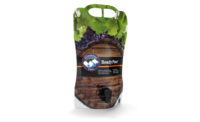Materials Technology: Flexible Packaging
Stand-up pouches: Converting considerations for brand packagers
With stand-up pouch demand rising, brand packagers face strategic make-or-buy decisions.

Pre-made SUPs can be produced in novel pouch shapes and with innovative add-on features such as sliders and handles.
The stand-up pouch (SUP) continues to be a darling of the packaging industry. Brand packagers are eager to satisfy consumer appetites for pouch convenience, ease of use and quality.
Market data shows SUP demand staying strong for the foreseeable future. Technology research company Technavio (technavio.com) estimates the SUP compounded annual growth rate will be 9.67% through 2019. As well, market research firm The Freedonia Group (freedoniagroup.com) predicts U.S. SUP demand will reach $2.4 billion in 2018.
Brand packagers have flexibility with SUPs. To cost-effectively fulfill demand and place good-looking product on retail shelves, they can buy pre-made SUPs, make them in-house or pursue both paths. There are advantages and disadvantages to each decision.
Pre-Made Pouch Procurement
When brands buy pre-made SUPs, they can present consumers with novel pouch shapes and innovative add-on features – such as zippers, sliders, spouts, assorted handles, choke-avoidance safety caps for baby food pouches and laser scoring for easy opening. Pre-made SUPs can also have a customized design uniquely contoured for smooth pouring.
Pre-made pouch suppliers can easily change pouch dimensions, shapes, fitments, closures and order quantities to help brands meet evolving demand. The pouches can be configured to include transparent windows, crisp seams and bottom and side gussets, creating a rich canvas for brand graphics and messaging. By comparison, pouches made on in-house form/fill/seal (f/f/s) equipment are more likely to have flatter, thinner seams and are more prone to film wrinkles.
Brands that work with a vertically integrated supplier also can benefit from a seamless flow of their packaging through every stage, including pre-production design, film extrusion, cylinder engraving, roll stock printing, laminating, slitting, rewinding and converting into SUPs.
One disadvantage of pre-made pouches is evident in the filling process, which cannot meet f/f/s’ potential for automation. Pre-made pouch filling is a semi-automated activity that can require more employees than f/f/s processes. So, while buying pre-made pouches reduces a packager’s capital equipment requirements, there are pouch filling labor costs on top of the pouch price per unit.
In-House Pouch Production
SUP f/f/s cost and efficiency benefits are prompting more brand packagers to consider a transition from buying pre-formed SUPs to producing their own pouches in-house. When making the move to in-house pouch production, a business typically invests in either vertical or horizontal f/f/s machinery. With vertical f/f/s, the product automatically flows vertically down into the formed pouch before the pouch is sealed. With horizontal f/f/s, the product rolls or slides horizontally into the package before sealing. When integrated with automated feed systems, these machines have very fast throughput. For example, some machines can form, fill and seal 80 to 200 bags per minute.
While SUPs made on f/f/s equipment tend to be basic in their design, they can incorporate some fitments and special features. For instance, advances in f/f/s machinery enable it to be upgraded with zipper applications. Also, some roll stock suppliers can embed pre-applied interlock zippers into their roll film, allowing packagers to add a pouch zipper without significant modifications to their f/f/s machines. Likewise, laser perforations integrated into roll stock enable packagers to incorporate easy-tear openings on their SUPs.
Common Denominator: Roll Stock Printed Film
Whether a brand packager chooses to buy pre-formed pouches or make SUPs in-house, a common denominator should be high-quality roll stock printed film. Leading roll stock suppliers have proven track records for providing consistent print and color quality throughout every roll. Their film features a stable lamination bond, reducing risk for bubbles or an “orange peel” mottled appearance. Suppliers also should offer consistent roll configuration so that printed laminate rolls are wound to just the right tightness and have flush, even ends – both of which help to ensure smooth processing through f/f/s machinery. To that end, some suppliers provide technical assistance to brand packagers who want to be sure their roll stock is engineered to suit a specific f/f/s equipment model.
Diverse printing capabilities are crucial for SUP roll stock providers. Top vendors offer rotogravure, high-definition flexographic, standard flexographic and extended gamut printing all under one roof.
In-house SUP f/f/s can be an attractive option for brands, especially for products with razor-thin profit margins. At the same time, packagers can deploy f/f/s pouches in their most price-sensitive product categories and leverage pre-made pouches, with their aesthetic appeal and higher-quality perception, for products that must stand out in a crowded field of competitors. Either way, the SUP promises to continue attracting consumers with its winning combination of solid branding, end-user functionality and superior convenience.
Looking for a reprint of this article?
From high-res PDFs to custom plaques, order your copy today!






